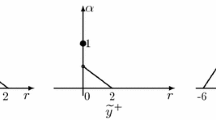Abstract
In this paper, we have presented fuzzy primal-dual quadratic programming problems and proved appropriate duality results taking exponential membership function.
Similar content being viewed by others
References
Abdel-Malek L L, Areeractch N (2007) A quadratic programming approach to the multi-product newsvendor problem with side constraints. European Journal of Operational Research 176: 855–861
Ammar E, Khalifa H A (2003) Fuzzy portfolio optimization a quadratic programming approach. Chaos Solitons and Fractals 18: 10–54
Zhang W G, Nie Z K (2005) On admissible efficient portfolio selection policy. Applied Mathematics and Computation 169: 608–623
Dwyer T, Koren Y, Marriott K (2006) Drawing directed graphs using quadratic programming. IEEE Transaction Visualization and Computer Graphics 12: 536–548
Petersen J A M, Bodson M (2006) Constrained quadratic programming techniques for control allocation. IEEE Transaction on Control System Technology 14: 91–98
Pavlovi L, Divni T (2007) A quadratic programming approach to the randi index. European Journal of Operational Research 176: 435–444
Schwarz H G (2006) Economic material-product chain models: current status, further development and an illustrative example. Ecological Economics 58: 373–392
Ammar E (2000) Interactive stability of multiobjective NLP problems with fuzzy parameters in the objective functions and constraints. Fuzzy Sets and Systems 109: 83–90
Chen S P (2004) Parametric nonlinear programming for analyzing fuzzy queues with finite capacity. European Journal of Operational Research 157: 429–438
Liu S T (2004) Fuzzy geometric programming approach to a fuzzy machining economics model. International Journal Production Research 42: 3253–3269
Nieto J J, Rodaiguez-Lopez R (2006) Bounded solutions for fuzzy differential and integral equations. Chaos, Solitons and Fractals 27: 1376–1386
Roman-Florse H, Chalco-Cano Y (2006) Some chaotic properties of Zaheh’s extensions. Chaos, Solitons and Fractals 35: 452–459
Sakawa M (1993) Fuzzy sets and interactive multiobjective optimization. New York: Plenum Press
Soleimani-damaneh M (2006) Fuzzy upper bounds and their applications. Chaos, Solitons and Fractals 36: 217–225
Stefanini L, Sorini L, Guerra M L (2006) Solution of fuzzy dynamical systems using the LU-representation of fuzzy numbers. Chaos, Solitons and Fractals 29: 638–652
Bellman R E, Zadeh L A (1970) Decision Making in a Fuzzy Environment. Management Science 17: 141–164
Slowinski R (ed.) (1998) Fuzzy sets in decision analysis, Operations Research and Statistics. Boston: Kluwer Academic Publishers
Delgado M, Kacprzyk J, Verdegay J-L, Vila M A (ed.) (1994) Fuzzy optimization: Recent advances. New York, Physica-Verlag
Rodder W, Zimmermann H-J (1980) Duality in fuzzy linear programming. In: A.V. Fiacco, K.O. Kortanek (Eds.), Extremal Methods and System Analysis, Berlin, New York, pp. 415–429
Hamacher H, Leberling H, Zimmermann H J (1978) Sensitivity analysis in fuzzy linear programming. Fuzzy Sets and Systems 1: 269–281
Bector C R, Chandra S (2002) On duality in linear programming under fuzzy environment. Fuzzy Sets and Systems 125(3): 317–325
Liu Y J, Shi Y, Liu Y H (1995) Duality of fuzzy MC2 linear programming: a constructive approach, Journal of Mathematical Analysis and Applications 194: 389–413
Bector C R, Chandra S (2005) Fuzzy mathematical programming and fuzzy matrix games. Springer, Berlin, Heidelberg
Bector C R, Chandra S, Vijay V (2004) Matrix games with fuzzy goals and fuzzy linear programming duality. Fuzzy Optimization and Decision Making 3(3): 255–269
Bector C R, Chandra S, Vijay V (2004) Duality in linear programming with fuzzy parameters and matrix games with fuzzy pay-offs. Fuzzy Sets and Systems 146(2): 253–269
Vijay V, Chandra S, Bector C R (2005) Matrix games with fuzzy goals and fuzzy pay offs. Omega 33(5): 425–429
Gupta Pankaj, Mehlawat Mukesh Kumar (2009) Bector-Chandra type duality in fuzzy linear programming with exponential membership functions. Fuzzy Sets and Systems 160: 3290–3308
Hersh H M, Caramazza A (1976) A fuzzy set approach to modifiers and vagueness in natural language. Journal of Experimental Psychology 105(3): 254–276
Mangasarian O L (1994) Nonlinear Programming, SIAM, Philadelphia, PA
Zimmermann H J (1978) Fuzzy programming and linear programming with several objective functions. Fuzzy Sets and Systems 1: 45–55
Author information
Authors and Affiliations
Corresponding author
About this article
Cite this article
Gupta, S.K., Dangar, D. Duality in fuzzy quadratic programming with exponential membership functions. Fuzzy Inf. Eng. 2, 337–346 (2010). https://doi.org/10.1007/s12543-010-0054-5
Received:
Revised:
Accepted:
Published:
Issue Date:
DOI: https://doi.org/10.1007/s12543-010-0054-5




